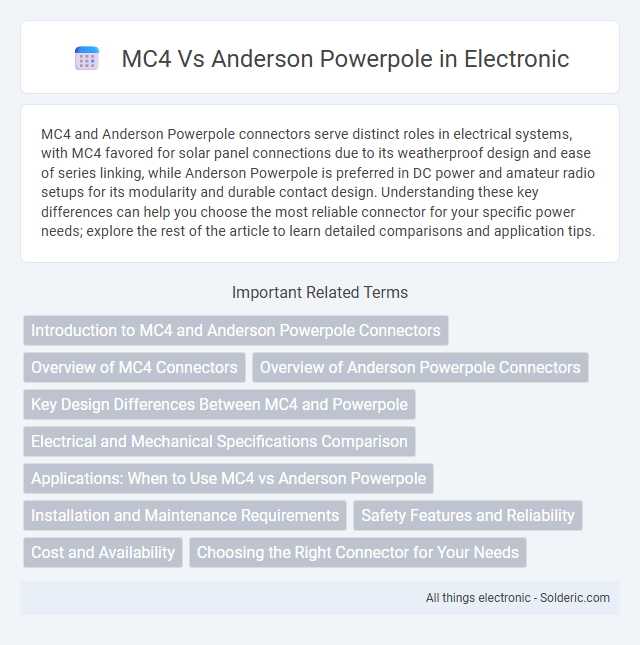MC4 and Anderson Powerpole connectors serve distinct roles in electrical systems, with MC4 favored for solar panel connections due to its weatherproof design and ease of series linking, while Anderson Powerpole is preferred in DC power and amateur radio setups for its modularity and durable contact design. Understanding these key differences can help you choose the most reliable connector for your specific power needs; explore the rest of the article to learn detailed comparisons and application tips.
Comparison Table
| Feature | MC4 Connector | Anderson Powerpole |
|---|---|---|
| Usage | Solar panel connections | General DC power applications |
| Current Rating | Up to 30A continuous | Up to 45A continuous (varies by model) |
| Voltage Rating | Up to 1000V DC | Up to 600V DC or AC |
| Contact Material | Copper with silver or tin plating | Copper with tin plating |
| Gender | Male and female connectors | Genderless, mate by keying |
| Locking Mechanism | Snap-lock with positive locking clip | Friction fit, keyed for polarity |
| Waterproof Rating | IP67 (dust-tight, waterproof) | Not inherently waterproof; requires additional sealing |
| Wire Size Compatibility | Typically 12-10 AWG | 8-10 AWG (standard 15-45A models) |
| Typical Applications | Photovoltaic systems, solar arrays | Amateur radio, robotics, battery packs |
| Price | Moderate to high | Moderate |
Introduction to MC4 and Anderson Powerpole Connectors
MC4 connectors are widely used in solar energy systems for their waterproof and UV-resistant features, facilitating secure and reliable photovoltaic panel connections. Anderson Powerpole connectors provide modular, genderless design ideal for DC power distribution in various applications, known for high current capacity and ease of assembly. Both connectors offer efficient electrical connections but serve distinct purposes in solar and general power systems, emphasizing durability and user-friendly installation.
Overview of MC4 Connectors
MC4 connectors are industry-standard electrical connectors primarily used for connecting solar panels due to their waterproof and UV-resistant design, ensuring durability in harsh outdoor environments. Their simple plug-and-play mechanism allows for secure, reliable, and weatherproof connections in photovoltaic systems, optimizing energy transfer efficiency. You can easily integrate MC4 connectors into your solar array for robust and safe power handling under high-voltage conditions.
Overview of Anderson Powerpole Connectors
Anderson Powerpole connectors provide a versatile and reliable solution for quick-disconnect power connections, widely favored in amateur radio and DC power distribution applications. Their genderless design and modular stacking capability ensure seamless customization for various amperage ratings, enhancing your system's flexibility and durability. Compared to MC4 connectors typically used in solar panel systems, Anderson Powerpoles offer easier assembly without specialized tools, making them ideal for field operations and DIY projects.
Key Design Differences Between MC4 and Powerpole
MC4 connectors feature a weatherproof, locking design ideal for solar panel connections, providing secure, corrosion-resistant contacts in outdoor environments. Anderson Powerpole connectors utilize a modular, genderless housing system enabling quick and versatile power connections across various applications, including industrial and emergency power systems. Your choice depends on whether you need weather-sealed reliability for solar setups or flexible, easy-to-use connectors for general DC power distribution.
Electrical and Mechanical Specifications Comparison
MC4 connectors feature rated voltages up to 1000V DC and current capacities typically around 30A, designed primarily for solar panel connections with weatherproof seals ensuring UV and water resistance. Anderson Powerpole connectors support voltages up to 600V DC and currents ranging from 15A to 350A depending on the contact size, offering a modular, genderless design ideal for various DC power applications requiring quick connection and disconnection. Your choice between MC4 and Anderson Powerpole should consider the electrical load requirements, environmental conditions, and mechanical robustness needed for your specific application.
Applications: When to Use MC4 vs Anderson Powerpole
MC4 connectors are ideal for solar panel installations, providing weatherproof, high-current DC connections suitable for outdoor use in renewable energy systems. Anderson Powerpole connectors excel in versatile, low-voltage DC applications such as robotics, amateur radio, and battery packs, offering modularity and quick-disconnect features. Your choice depends on the environment and electrical requirements: MC4 fits fixed solar arrays exposed to elements, while Anderson Powerpole suits portable or adaptable power setups.
Installation and Maintenance Requirements
MC4 connectors require specialized crimping tools and precise assembly to ensure a watertight seal, making installation more complex compared to Anderson Powerpole connectors. Anderson Powerpole connectors feature a modular, genderless design with easy snap-together assembly, significantly reducing installation time and simplifying maintenance. Regular inspection of MC4 connectors for moisture ingress is essential, while Anderson Powerpole connectors primarily need periodic cleaning and checking for secure connections.
Safety Features and Reliability
MC4 connectors are designed with weatherproof seals and locking mechanisms to prevent accidental disconnection, ensuring high reliability in outdoor solar installations. Anderson Powerpole connectors feature robust metal housings and genderless designs that provide secure, stable connections while allowing easy maintenance and replacement. Both connector types excel in safety, with MC4 offering superior waterproofing and Anderson Powerpole providing enhanced mechanical durability and contact stability.
Cost and Availability
MC4 connectors typically cost more than Anderson Powerpole connectors due to their specialized design for solar panel systems and are widely available through solar equipment suppliers. Anderson Powerpole connectors are generally more affordable, enjoy broad availability across various electronics and electrical retailers, and offer versatility for multiple low-voltage applications. Your choice may depend on budget constraints and the specific application, with Anderson Powerpoles providing cost-effective, readily accessible options.
Choosing the Right Connector for Your Needs
Choosing the right connector for your needs depends on the application requirements and current rating. MC4 connectors are widely used in solar panel systems for their waterproof design and compatibility with photovoltaic cables, supporting currents up to 30A. Anderson Powerpole connectors offer versatile, modular connectivity with high current capacity, typically up to 45A, making them suitable for DC power distribution and quick-disconnect scenarios in various electrical setups.
MC4 vs Anderson Powerpole Infographic

 solderic.com
solderic.com